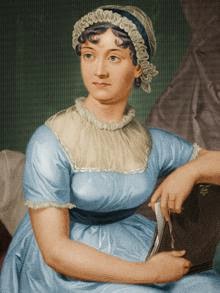Jane Austen’s Contribution to English Novel
 An objective and impartial estimation of Jane Austen’s contribution to the development of the English novel involve comparisons which are, also, likely to undermine her self-imposed limitations as an artist.
An objective and impartial estimation of Jane Austen’s contribution to the development of the English novel involve comparisons which are, also, likely to undermine her self-imposed limitations as an artist.Austen’s range is very narrow. The plots revolve around three or four families in the countryside, consisting mostly of a few typed characters. There is only one theme – the theme of love and marriage – repeated in every novel. Deep philosophy of life is conspicuously absent and there are no hidden meanings to be discovered. There are no adventures to thrill, no violent passions to ruffle, no sensations to tickle and tease. Yet she is one of our major novelists. Safely emerging through two centuries and severe criticism, today she enjoys secure reputation.
Austen’s first important achievement is to bring to the English novel dramatic plots. She has the genius of a great dramatist. Baker successfully verified the plot of “Pride and Prejudice”, in its various stages of development, to the pattern of a five-act play. The unity of purposes, the complete inter-dependence of the main plot and the sub-plots, the perfect association of the action and the characters, dramatic irony and short, engaging dialogues render her plots highly dramatic. To this may be added the objectivity of narration, the complete withdrawal of the creator from the creation, for she hardly speak in her own person to give a direct comment.
Jane Austen has given us a multitude of characters. All of them are commonplace such as we meet everybody.
Yet they are al perfectly discriminated from each other as if they were the most eccentric of human beings.
Remarkably, no two villains are alike, nor two fools for even the greatest novelists are guilty of repetition. However, her real achievement in characterization is the ironic exposition of the ‘follies and nonsense, whims and inconsistencies’ of human conduct. She excels in the depiction of the ridiculous and of the hiatus between a reality and an appearance, between a purpose and a pretence that amuses and entertains, but also perplexes and exasperates.
Another of her important preoccupations is the theme of self-education. Her protagonists are often self-deceived. They undergo a painful process of self-discovery but they have the humility and honesty to admit their earlier illusionment and the courage to give a new direction to their life.
Austen represents feminization of the English novels. She draws her men as they appear to women and not to men. Her Darcy and Bingley, Knightly and Frank Churchill are seen through the eyes of her women, Elizabeth, Jane and Emma. The men never appear alone; they are always in the company of women, engaged in such activities as women can participate in – balls, dinners, card sessions, or just walks. This accounts for the lack of masculinity in her novels. It imposes a serious limitation on her art as a novelist, but it need not be regretted; we praise it for its rarity.
The artistic excellence of Austen’s novels deserves high praise. The plots are contrived and executed with consummate skill. There are no digressions and no loose ends are left dangling. Among her characters, there are hardly any superfluous. The dialogues are natural, yet lively, they help in the development of plot as well as the evolution of character. Her style is balanced, even epigrammatic. Ruben A. Brower thinks that many pages of “Pride and Prejudice” can be read a sheer poetry of wit. Sir Walter Scott concedes that though her subjects are not often elegant and certainly never grand, they are finished up to Nature and with a precision. He further says:
The young lady had a talent for describing the involvements, feelings and characters are ordinary life … but the exquisite touch which renders commonplace things and characters interesting from the worth of the depiction and the sentiment is denied to me.
Jane Austen has often been called a pure novelist for her art is only for art’s sake and is a source of great aesthetic pleasure on account of its artistic exquisiteness. Besides, it is also the vehicle of her moral vision that being based on common sense is pretty sound. A. J. Wright comments:
Working with materials extremely limited in themselves, she develops themes of the broadest significance; the novels go beyond social record, beneath the didactic, to moral concern, perplexity and commitment.
At one level, her novels present an authentic record of the life of the upper middle classes in Southern England at the end of the eighteenth century, while at another level, her novels can be considered as broad allegories. “Pride and Prejudice” displays and illustrates the dangers of excessive Pride and overweening Prejudice. “Sense and Sensibility” vindicates Sense and exposes the dangers of Sensibility. Emma deals with self-deception. “Persuasions” describes the dangers of over-persuasion.
Her most important contribution to the English novels is her ironic world view. This view lies in the recognition of the fact that man is confronted with the choice of two things that are mutually exclusive. The two are equally attractive, equally desirable, but ironically, incompatible. Sense may be more desirable but Sensibility too is not without attraction or desirability and its claims. The irony is that the claims of “Sense and Sensibility” are conflicting.
Ironically, the theme of “Pride and Prejudice” is the contrast between Intricacy and Simplicity. Both the qualities have their own attractions and dangers in them. Darcy and Elizabeth are intricate and attractive but they are prone to the dangers that accompany such an intricacy. Jane and Bingley are simple, and they are free from such dangers but they are dull and lifeless. Perhaps one would like to be simple and intricate all at once, but that is not possible; which is the irony. Jane Austen projects this ironic world view practically in all her novels.

